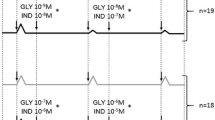Abstract
Tension and phosphatidyl inositol (PI) turnover experiments were conducted to investigate the receptors and signal transduction pathways responsible for contractions elicited by endothelin (ET) ligands in human bronchus. Nicardipine (1 µM), the L-type calcium channel inhibitor, or incubation in Ca2+-free medium, produced marked inhibition of contractions to the ETB receptor-selective agonist, sarafotoxin S6c, and especially those induced by KCl. In contrast, Ca2+-free medium was without appreciable effect against contraction produced by endothelin-1 (ET-1), the non-selective ETA and ETB receptor agonist. In Ca2+-free medium, ryanodine (10 µM), which inhibits intracellular calcium mobilization, reduced sarafotoxin S6c- and ET-1-induced responses, but was without effect on responses to KCl. Similarly, nickel chloride (Ni2+; 1 mM) caused marked inhibition of contractions induced by sarafotoxin S6c or ET-1, but had no significant effect on KCl concentration-response curves. The mixed ETA/ETB receptor antagonist SB 209670 (3 µM) inhibited responses to sarafotoxin S6c and ET-1 such that concentration-response curves were shifted rightward, at the 30% maximum response level, by 10.0- and 3.8-fold, respectively, whereas BQ-123 (3 µM), the ETA receptor antagonist, was without effect on responses induced by either agonist. ET-1 (1 nM–0.3 µM) caused a concentration-dependent stimulation of PI turnover, whereas sarafotoxin S6c (0.3 nM–0.1 µM) induced only small and variable increases, except at the highest concentration. The increase in PI turnover evoked by ET-1 was inhibited by SB 209670 (3 µM), and also by BQ-123 (3 µM). This is consistent with linkage of ETA receptors to activation of inositol phosphate generation in human bronchial smooth muscle cells. Collectively, the data suggest that differences exist in the relative contributions of intracellular and extracellular Ca2+ mobilization mechanisms elicited by ETA and ETB receptor activation. Thus, sarafotoxin S6c-induced, ETB receptor-mediated contraction in human bronchial smooth muscle appears to be dependent, in part, upon extracellular Ca2+, although a significant component of the response was also mediated by intracellular Ca2+ release, including from ryanodine-sensitive stores. ETA receptor-mediated contraction of human airway smooth muscle was activated largely via the release of intracellular Ca2+.
Similar content being viewed by others
Author information
Authors and Affiliations
Additional information
Received: 21 July 1998 / Accepted: 26 January 1999
Rights and permissions
About this article
Cite this article
Hay, D., Luttmann, M., Muccitelli, R. et al. Endothelin receptors and calcium translocation pathways in human airways. Naunyn-Schmiedeberg's Arch Pharmacol 359, 404–410 (1999). https://doi.org/10.1007/PL00005368
Issue Date:
DOI: https://doi.org/10.1007/PL00005368




